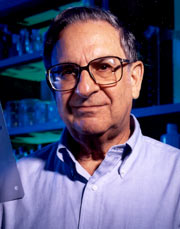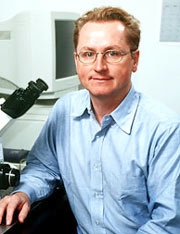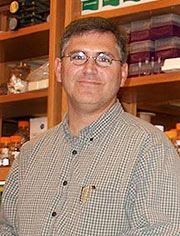Science Talk:
After the Genome, Part 2
 The Paradigm Remains the Same
The Paradigm Remains the Same
Ernest Beutler, Chair, Department of Molecular and
Experimental Medicine
Having the sequence of the whole genome is a useful
tool [rather than] an entirely new concept (In other
words, I don't agree with the idea that "It's a new
ballgame now that we know the genome"). Knowing the
sequence allows us to move towards our objectives more
rapidly—whether that objective is finding a new
drug target or solving a problem with a genetic disease.
That's all it really is—a tool. And it's a tool
that didn't suddenly become available when people announced
that they had completed the sequence. We've been able
to perform genome searches for the last 14 years. It's
just that now, the database is more complete, although
still not entirely so.
There are a lot of different ways to use this tool
to find better drug targets. One is the forward genetic
approach—random mutagenesis. If you produce a model
with hypertension or diabetes or cancer as an inherited
genotype, you perform linkage analysis. There are lots
of markers that help you see what piece of which chromosomes
have been inherited from which strain. Then you narrow
the field to a single gene by what is known as positional
cloning.
Could you positionally clone a gene before the genome
was available? Sure, but it was a lot more work. It
was a lot harder. Now areas that you would have had
to sequence through are already sequenced. Markers that
you would have had to find are already known. The availability
of the genome allows you to find a mutant gene much
faster, and, once you find the gene that causes the
phenotype, then you may gain some understanding of why
this strain has this particular disease. Once you have
that understanding, then maybe you'll be able to treat
the disease and its human counterpart.
The paradigm hasn't changed. Once you find the pathogenesis
of a disease, then you try to correct that through drugs,
diet, and a variety of different ways. Is [the genome]
a revolution? I don't think so. But it's a very powerful
tool for understanding disease processes, and it will
move things along a lot faster.
|
 Making
a Mark Making
a Mark
Steve Kay, Professor, Department of Cell Biology
Genomics aims to provide a definition of the gene content
of an organism. Functional genomics takes the genome
sequences and turns them into highly confident statements
about how many genes there are and what they do. It's
going to provide rich biological descriptions of function
on a scale that was unimaginable a few years ago.
What is really exciting is that much of the effort
at TSRI's Institute of Childhood and Neglected Diseases
(ICND) is about neurobiology—trying to understand
the molecular and cellular bases of psychiatric and
neurological disorders. It is extremely difficult to
define gene-by-gene how each may contribute to complex
behavior, for example, the sleep/wake cycle and how
it relates to depression; learning and memory; autism
and neurodegeneration; cerebellum disorders like epilepsy
and migraines; deafness.
One of the best ways of defining how genes contribute
to these complex biological phenomena is to use an in
vivo standard—a working physiological system
to see how the genes work. At the ICND, we are fortunate
to have a partnership with the Genomics Institute of
the Novartis Research Foundation (GNF), which will make
these models available for researchers. This is critically
important for finding new targets for therapeutic intervention.
We can assay complex [phenotypes] and begin to determine
which genes are important for biological function and
which are important for dysfunction.
Genes want to express themselves and they do it differentially.
Every single cell has the same DNA content, but they
look different because of differential expression.
Differential expression mapping is a powerful way
of assigning function. A lot of people in the ICND are
interested in using gene expression analysis as a way
of assigning function to genes. What we did recently
was to identify a potassium channel that plays a key
role in regulating the sleep/wake cycle. This provides
a target for therapy.
The investment that the institute has made in facilities,
recruitment, and opportunities for interacting with
GNF in the past three years has provided the infrastructure
we needed to carry out functional genomics. Now we are
seeing it pay off in publications and in making a mark.
|
 Proteomics,
Mass Spectrometry, and Post-Translational Modification Proteomics,
Mass Spectrometry, and Post-Translational Modification
John Yates, Professor, Department of Cell Biology
The genome sequence tells you a lot about an organism,
but it doesn't tell you everything. The next level up
is the proteome. What makes proteomics more challenging
than genomics is the fact that [the proteome is dynamic]—depending
on the given cellular state, environment, and so forth,
you get a different proteome expressed. Although our
genome is the same in every single cell in the body,
the kinds of proteins that are expressed in those cells
will be very different, depending on what the cell is
supposed to be doing.
Lots of proteins come together to form complexes in
order to carry out some physiological function. We need
to know what proteins are coming together, when they
come together, what's driving them together, what is
the stoichiometry of those complexes—how many of
each of these components are in there, things like that.
We also need information about post-translational modifications,
[which] turn out to be extremely interesting. There
are lots and lots of modifications, and the most common
modification that people correlate with regulation is
phosphorylation.
Phosphorylation is very widespread and it's important
to know when it's on and when it's off and how that
correlates with particular physiological processes.
You'll also find that acetylation and methylation may
have regulatory roles. There's a lot of interest now
in how those things might involve regulatory processesÉ
Even though you may have X amount of a particular protein,
how much of it is actually active? That may be a function
of the modification state of that particular protein.
Correlating those pieces of information will actually
be quite interesting.
[In proteomics], you need to be able to measure quickly,
robustly, and in a high-throughput fashion that kind
of information, and mass spectrometry [enables one to
do just that].
We use tandem mass spectrometry, [which] allows you
to select peptides from the mixture and get fragmentation
information that tells you the sequence. What my lab
invented a long time ago is a way to take that mass
spectrometry fragmentation pattern and correlate it
with sequences in the database. So, as genomes get sequenced,
that information goes into the database and it becomes
very easy to associate that mass spectrometry data to
those sequences in the database, and you can do this
in a very high-throughput manner.
It also enables new approaches for looking at protein
complexes, looking at the components of the cells, looking
at where proteins might localize, [and studying post-translational
modification]. If the computer program knows to check
for something like phosphorylation, it'll go and search
the sequence database. Every time it sees a residue
that could potentially be phosphorylated it's going
to ask the question, "is this phosphorylated or not?".
And you can do that with almost any kind of modification
in this world [with the possible exception of] carbohydrates...
|
 The
Study of the Glycome The
Study of the Glycome
James Paulson, Professor, Department of Molecular
Biology
The Consortium for Functional Glycomics is focused
on information carried by carbohydrates that mediate
communication between cells. As part of that, we want
to understand the regulation of the genes responsible
for the synthesis of the carbohydrate structures required
for mediating cell communication.
To that end, we have established a core resource that
operates within the existing TSRI Gene Microarray Facility.
The purpose is to create a custom array of genes that
are related to the scope of the consortium. We've just
finished assembling a list of about 1,500 human and
murine genes that include glycosyl transferases, which
are the enzymes that synthesize carbohydrates, and carbohydrate
binding proteins, the proteins that bind the structures
that appear on the surfaces of cells. And then there
are classes of related genes of interest.
The array will be produced by Affymetrix [a firm that
develops technology for acquiring, analyzing, and managing
genetic information] who will take the list we developed
and create a custom gene chip [an array of nucleotides
on a solid surface]. We're doing that for two reasons.
We'll have a well focused set of genes that are well
annotated, and it's also cost-effective. Within two
months, we should have [the chips] in-house.
Once they are available, investigators will apply
to use the chips for experiments within the scope of
the consortium. We will either send them the chips (if
they have their own array facility), or they can send
us the RNA needed to analyze gene expression using the
chips, and we can do the work here and send them the
data. In either case, the (raw and analyzed) data will
be posted on a public web site.
Now that the genome has been completed, there is a
general interest in the other layers of complexity that
define an organism as complex as a human. In the post-genomic
era, interest has shifted towards these other layers
of complexity including glycomics, the study of the
glycome [all the carbohydrates in the human body]. I
don't think we're ready yet to do the same kind of comprehensive
analysis with the glycome that has been done with the
genome, because to do that, you would need to categorize
every single carbohydrate that is produced on every
single cell type in the organism. And even every glycoprotein
produced in every cell.
We know, based on a lot of work through the years,
that most of that information will not be particularly
useful. It will be re-documenting over and over again
very similar carbohydrate structures. That's why our
focus has been functional glycomics, where we're trying
to sort out the sugar structures that do make a difference,
that do participate in biological interactions. Use
of the glyco-gene microarray will be particularly valuable
to understanding how glycosylation of a cell changes
during differentiation and / or activation.
|

|
|

